FORD EXPLORER 2012 5.G Owners Manual
Manufacturer: FORD, Model Year: 2012, Model line: EXPLORER, Model: FORD EXPLORER 2012 5.GPages: 439, PDF Size: 3.63 MB
Page 161 of 439
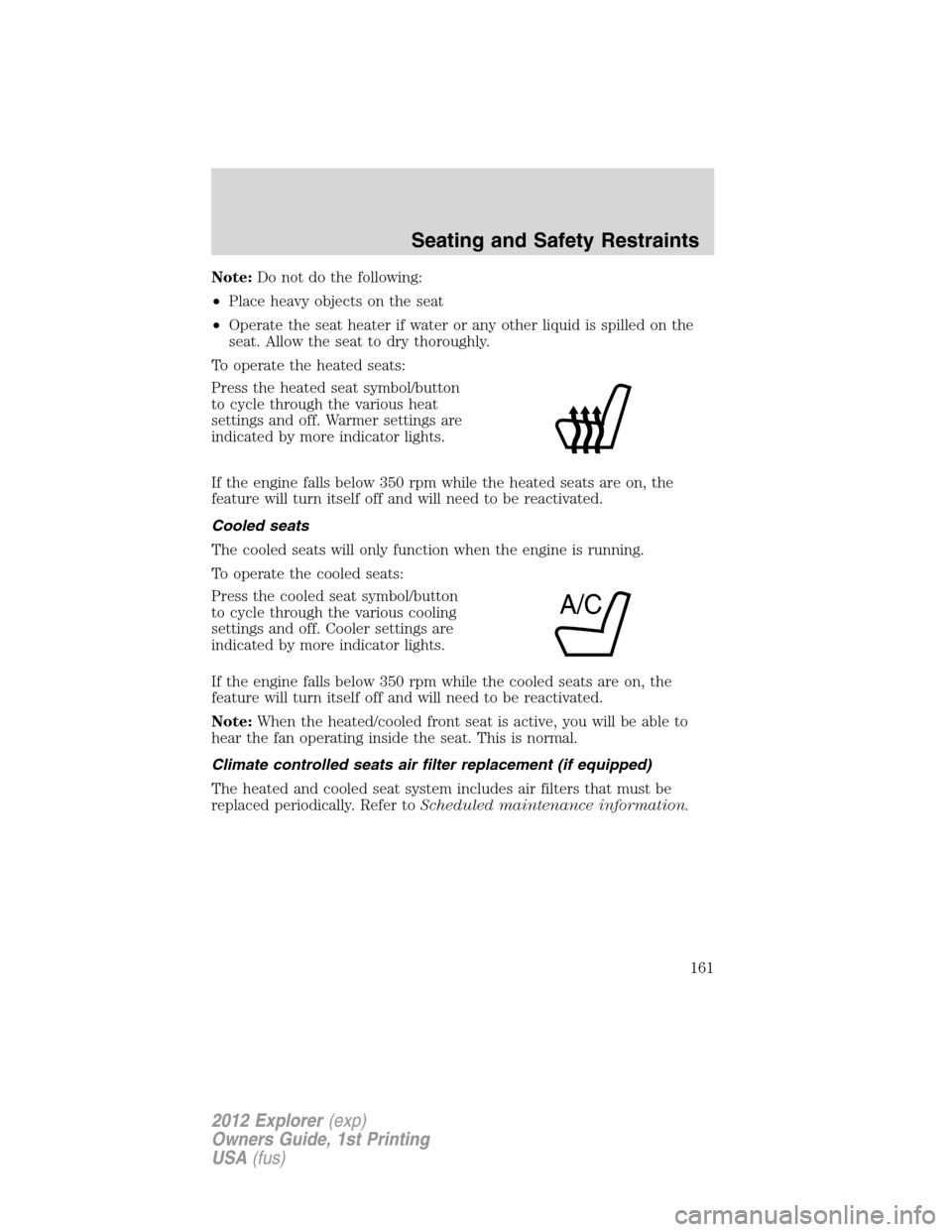
Note:Do not do the following:
•Place heavy objects on the seat
•Operate the seat heater if water or any other liquid is spilled on the
seat. Allow the seat to dry thoroughly.
To operate the heated seats:
Press the heated seat symbol/button
to cycle through the various heat
settings and off. Warmer settings are
indicated by more indicator lights.
If the engine falls below 350 rpm while the heated seats are on, the
feature will turn itself off and will need to be reactivated.
Cooled seats
The cooled seats will only function when the engine is running.
To operate the cooled seats:
Press the cooled seat symbol/button
to cycle through the various cooling
settings and off. Cooler settings are
indicated by more indicator lights.
If the engine falls below 350 rpm while the cooled seats are on, the
feature will turn itself off and will need to be reactivated.
Note:When the heated/cooled front seat is active, you will be able to
hear the fan operating inside the seat. This is normal.
Climate controlled seats air filter replacement (if equipped)
The heated and cooled seat system includes air filters that must be
replaced periodically. Refer toScheduled maintenance information.
A/C
Seating and Safety Restraints
161
2012 Explorer(exp)
Owners Guide, 1st Printing
USA(fus)
Page 162 of 439
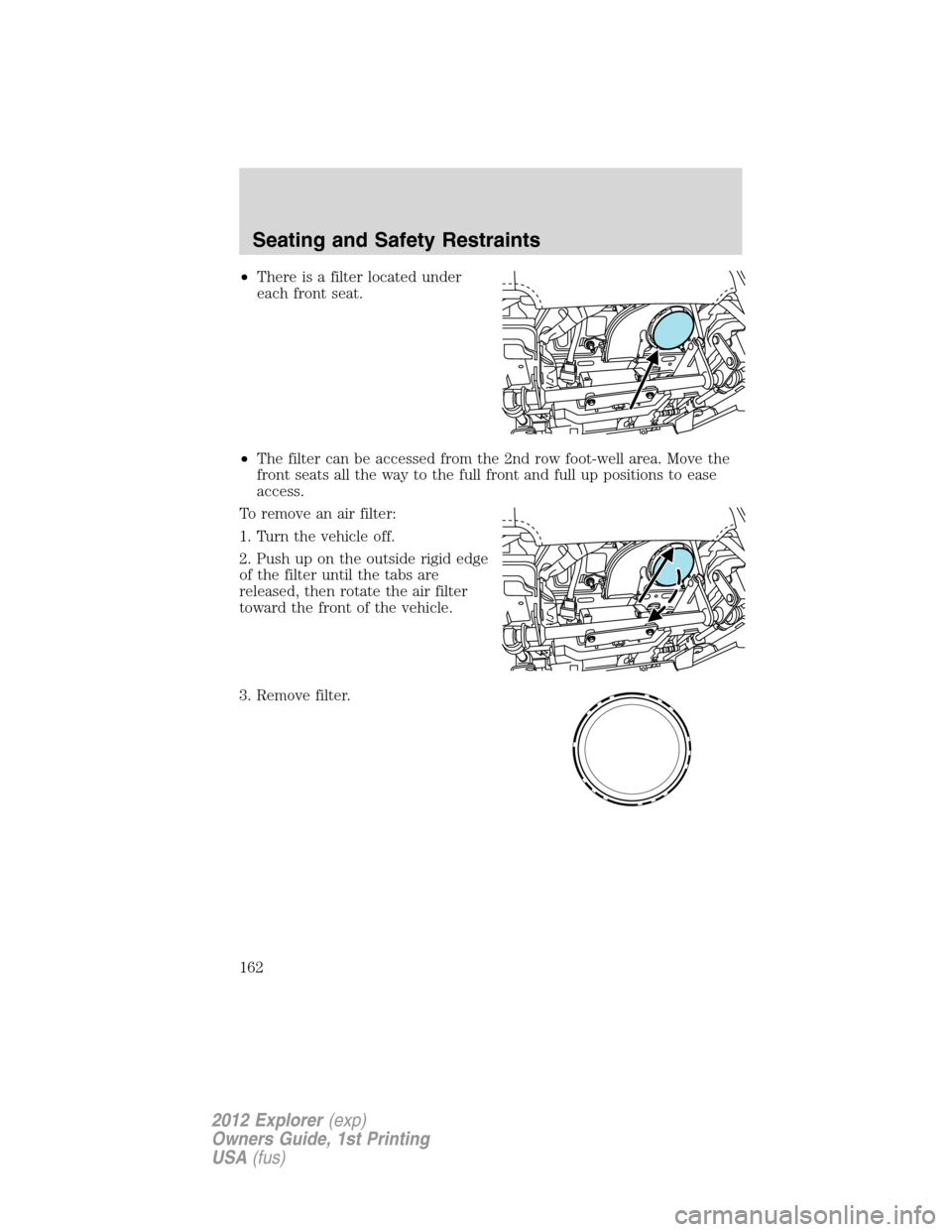
•There is a filter located under
each front seat.
•The filter can be accessed from the 2nd row foot-well area. Move the
front seats all the way to the full front and full up positions to ease
access.
To remove an air filter:
1. Turn the vehicle off.
2. Push up on the outside rigid edge
of the filter until the tabs are
released, then rotate the air filter
toward the front of the vehicle.
3. Remove filter.
Seating and Safety Restraints
162
2012 Explorer(exp)
Owners Guide, 1st Printing
USA(fus)
Page 163 of 439
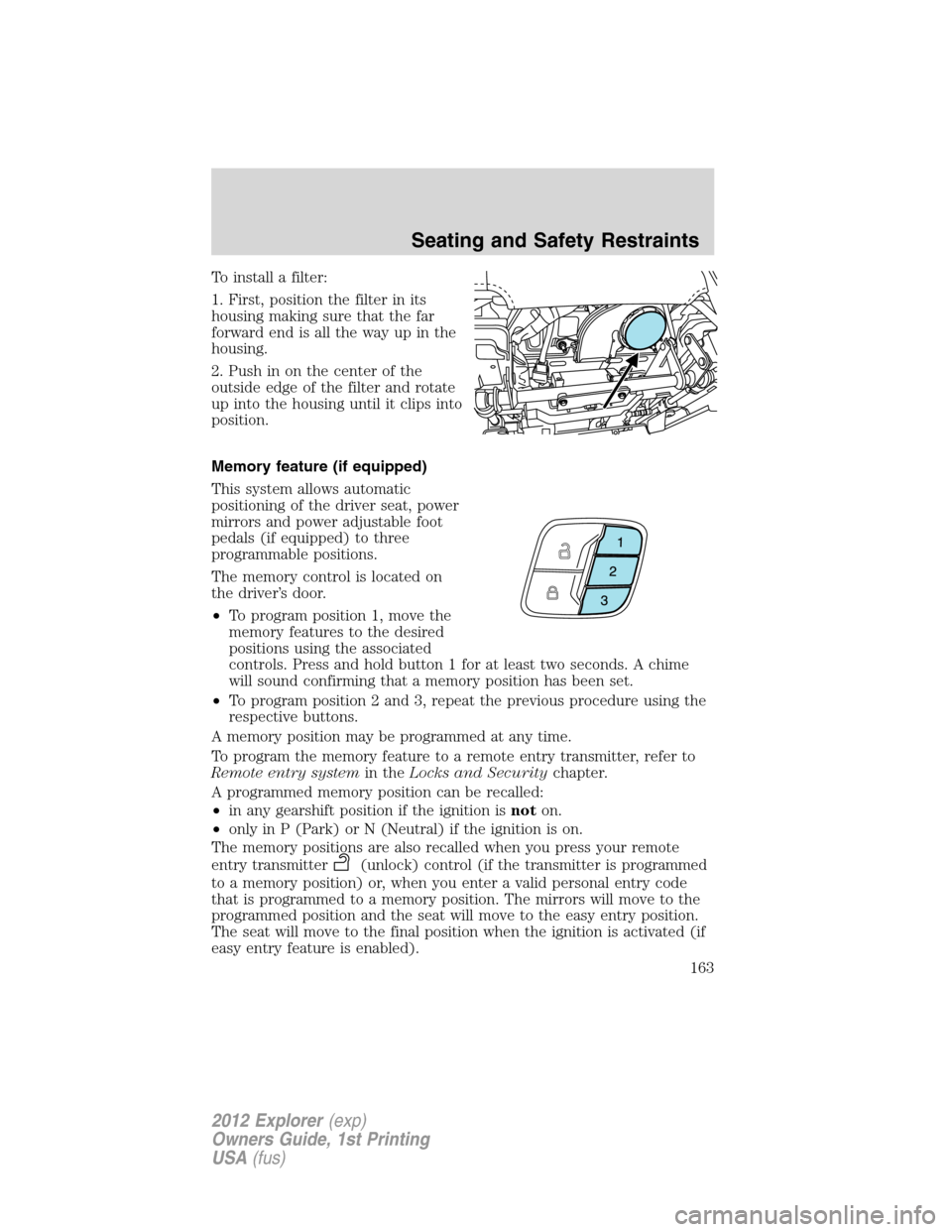
To install a filter:
1. First, position the filter in its
housing making sure that the far
forward end is all the way up in the
housing.
2. Push in on the center of the
outside edge of the filter and rotate
up into the housing until it clips into
position.
Memory feature (if equipped)
This system allows automatic
positioning of the driver seat, power
mirrors and power adjustable foot
pedals (if equipped) to three
programmable positions.
The memory control is located on
the driver’s door.
•To program position 1, move the
memory features to the desired
positions using the associated
controls. Press and hold button 1 for at least two seconds. A chime
will sound confirming that a memory position has been set.
•To program position 2 and 3, repeat the previous procedure using the
respective buttons.
A memory position may be programmed at any time.
To program the memory feature to a remote entry transmitter, refer to
Remote entry systemin theLocks and Securitychapter.
A programmed memory position can be recalled:
•in any gearshift position if the ignition isnoton.
•only in P (Park) or N (Neutral) if the ignition is on.
The memory positions are also recalled when you press your remote
entry transmitter
(unlock) control (if the transmitter is programmed
to a memory position) or, when you enter a valid personal entry code
that is programmed to a memory position. The mirrors will move to the
programmed position and the seat will move to the easy entry position.
The seat will move to the final position when the ignition is activated (if
easy entry feature is enabled).
Seating and Safety Restraints
163
2012 Explorer(exp)
Owners Guide, 1st Printing
USA(fus)
Page 164 of 439
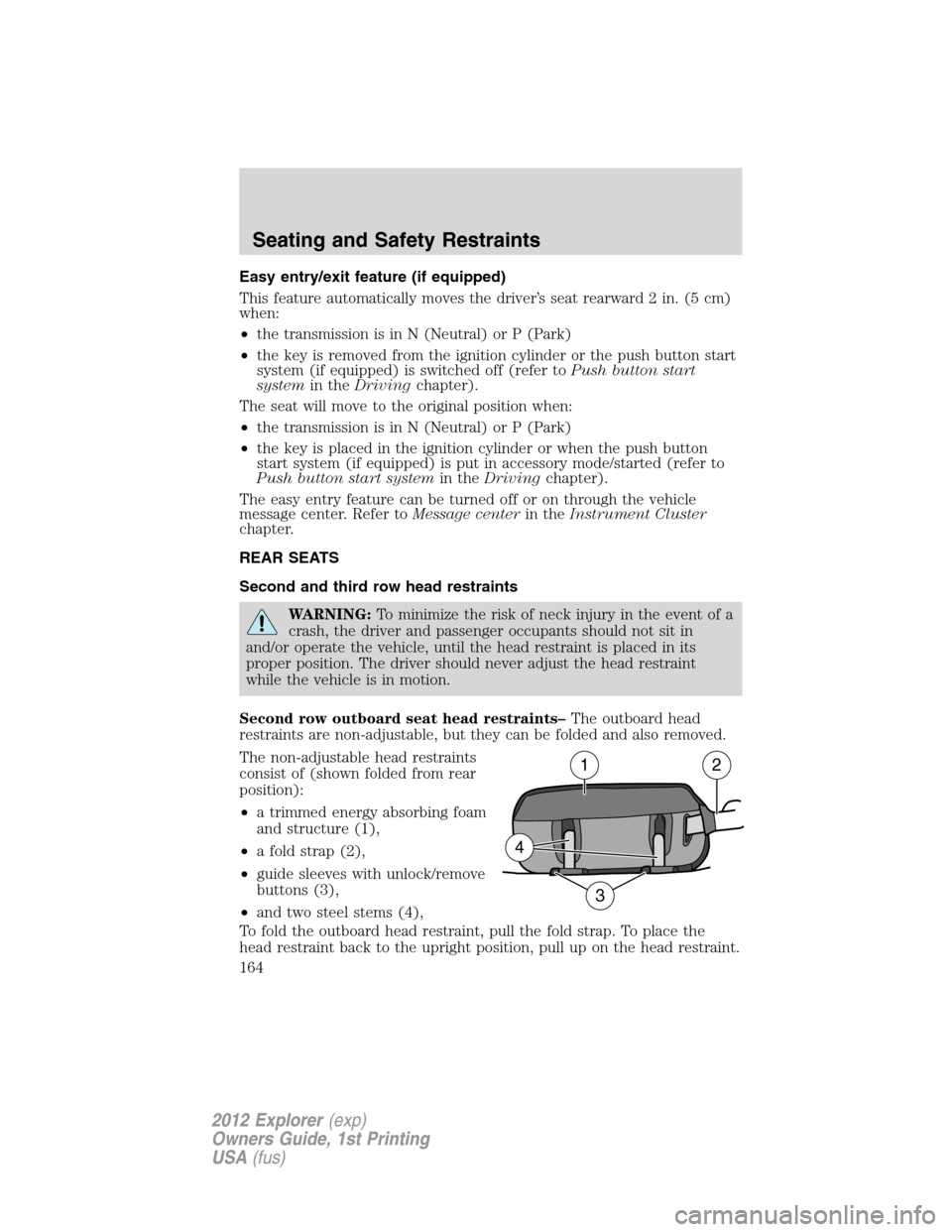
Easy entry/exit feature (if equipped)
This feature automatically moves the driver’s seat rearward 2 in. (5 cm)
when:
•the transmission is in N (Neutral) or P (Park)
•the key is removed from the ignition cylinder or the push button start
system (if equipped) is switched off (refer toPush button start
systemin theDrivingchapter).
The seat will move to the original position when:
•the transmission is in N (Neutral) or P (Park)
•the key is placed in the ignition cylinder or when the push button
start system (if equipped) is put in accessory mode/started (refer to
Push button start systemin theDrivingchapter).
The easy entry feature can be turned off or on through the vehicle
message center. Refer toMessage centerin theInstrument Cluster
chapter.
REAR SEATS
Second and third row head restraints
WARNING:To minimize the risk of neck injury in the event of a
crash, the driver and passenger occupants should not sit in
and/or operate the vehicle, until the head restraint is placed in its
proper position. The driver should never adjust the head restraint
while the vehicle is in motion.
Second row outboard seat head restraints–The outboard head
restraints are non-adjustable, but they can be folded and also removed.
The non-adjustable head restraints
consist of (shown folded from rear
position):
•a trimmed energy absorbing foam
and structure (1),
•a fold strap (2),
•guide sleeves with unlock/remove
buttons (3),
•and two steel stems (4),
To fold the outboard head restraint, pull the fold strap. To place the
head restraint back to the upright position, pull up on the head restraint.
1
4
2
3
Seating and Safety Restraints
164
2012 Explorer(exp)
Owners Guide, 1st Printing
USA(fus)
Page 165 of 439
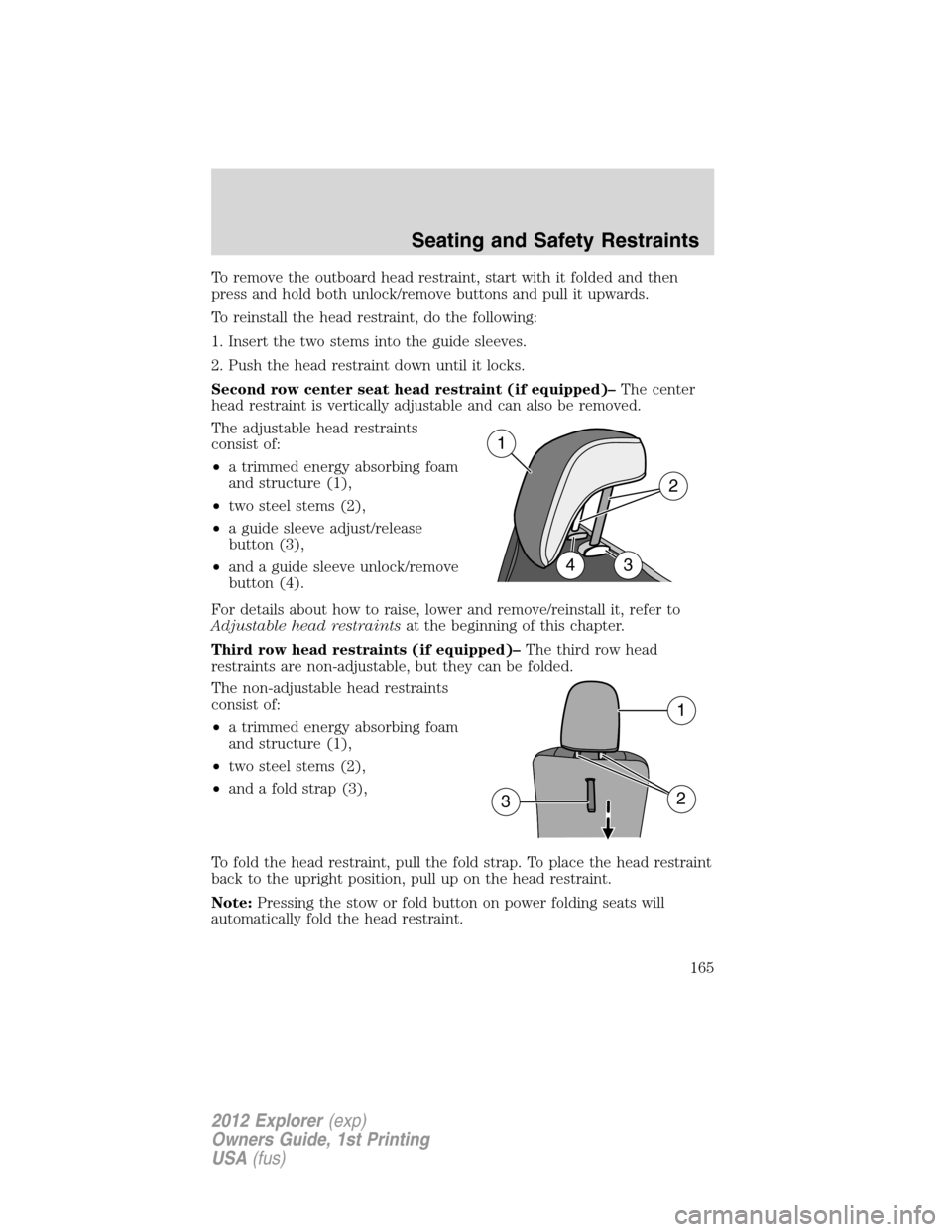
To remove the outboard head restraint, start with it folded and then
press and hold both unlock/remove buttons and pull it upwards.
To reinstall the head restraint, do the following:
1. Insert the two stems into the guide sleeves.
2. Push the head restraint down until it locks.
Second row center seat head restraint (if equipped)–The center
head restraint is vertically adjustable and can also be removed.
The adjustable head restraints
consist of:
•a trimmed energy absorbing foam
and structure (1),
•two steel stems (2),
•a guide sleeve adjust/release
button (3),
•and a guide sleeve unlock/remove
button (4).
For details about how to raise, lower and remove/reinstall it, refer to
Adjustable head restraintsat the beginning of this chapter.
Third row head restraints (if equipped)–The third row head
restraints are non-adjustable, but they can be folded.
The non-adjustable head restraints
consist of:
•a trimmed energy absorbing foam
and structure (1),
•two steel stems (2),
•and a fold strap (3),
To fold the head restraint, pull the fold strap. To place the head restraint
back to the upright position, pull up on the head restraint.
Note:Pressing the stow or fold button on power folding seats will
automatically fold the head restraint.
1
34
2
1
32
Seating and Safety Restraints
165
2012 Explorer(exp)
Owners Guide, 1st Printing
USA(fus)
Page 166 of 439

Adjusting second row bucket and bench seat back
Lift the handle to adjust seatback.
Using same control will fold the
seatback flat.
Note:For the bench seat only,
make sure the center safety belt is
unbuckled before folding the
seatback.
WARNING:Always drive and ride with your seatback upright
and the lap belt snug and low across the hips.
WARNING:Reclining the seatback can cause an occupant to
slide under the seat’s safety belt, resulting in severe personal
injuries in the event of a collision.
Adjusting second row seats (six–passenger vehicles only)
Lift the control to adjust the seat
forward or backward.
Accessing the third row seats
Fold and tumble the second row seat to access the third row. Remove
items from the second row seat and ensure that no bulky objects such as
purses or briefcases are on the floor in front of the second row seats
before tumbling them. For second row bench seats, make sure the center
safety belt is unbuckled before folding the seatback.
Note:You may have to move the front row seat forward to allow the 2nd
row seat to be fully tumbled.
1. Stow the center head restraint (if equipped) by pressing the head
restraint release button while sliding the head restraint fully down.
Seating and Safety Restraints
166
2012 Explorer(exp)
Owners Guide, 1st Printing
USA(fus)
Page 167 of 439
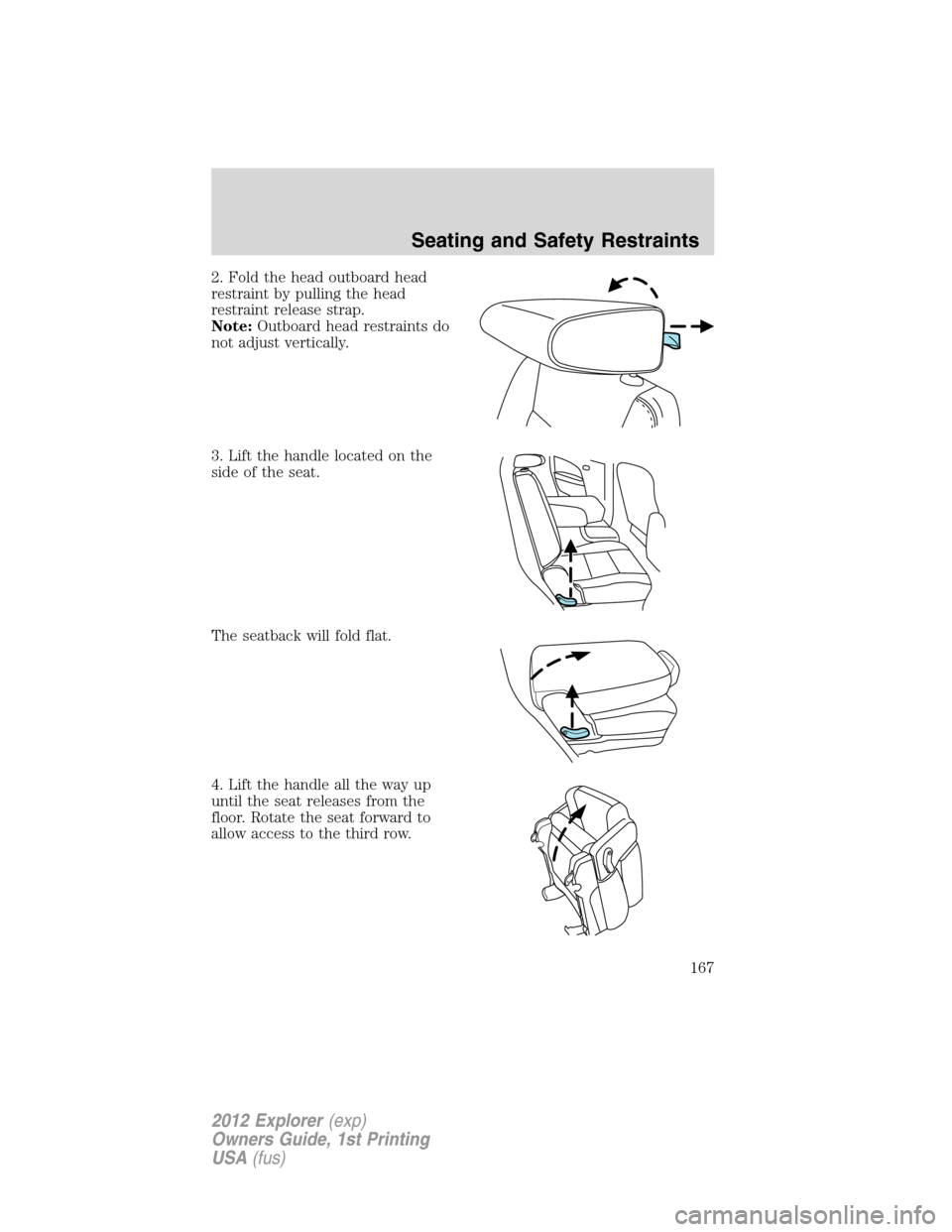
2. Fold the head outboard head
restraint by pulling the head
restraint release strap.
Note:Outboard head restraints do
not adjust vertically.
3. Lift the handle located on the
side of the seat.
The seatback will fold flat.
4. Lift the handle all the way up
until the seat releases from the
floor. Rotate the seat forward to
allow access to the third row.
Seating and Safety Restraints
167
2012 Explorer(exp)
Owners Guide, 1st Printing
USA(fus)
Page 168 of 439
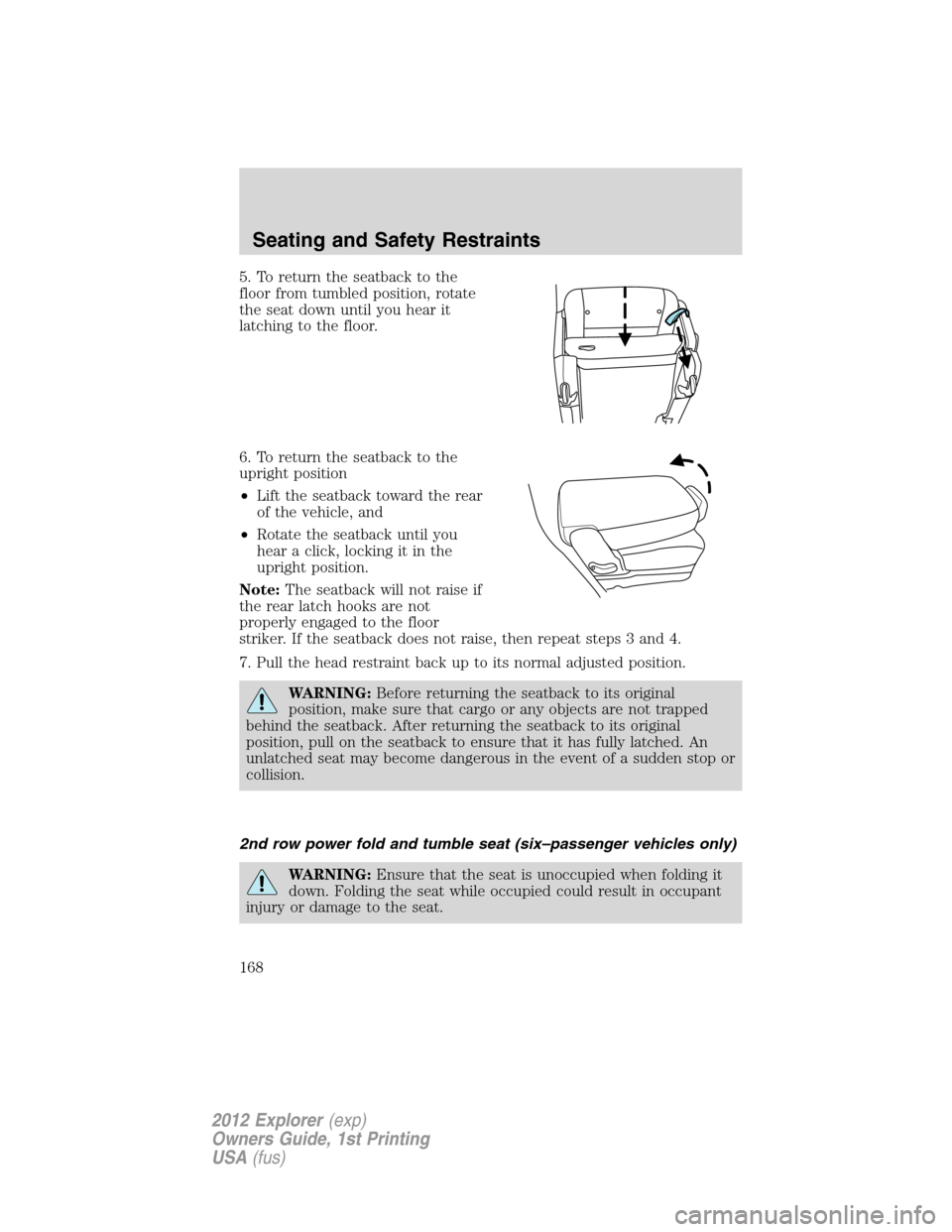
5. To return the seatback to the
floor from tumbled position, rotate
the seat down until you hear it
latching to the floor.
6. To return the seatback to the
upright position
•Lift the seatback toward the rear
of the vehicle, and
•Rotate the seatback until you
hear a click, locking it in the
upright position.
Note:The seatback will not raise if
the rear latch hooks are not
properly engaged to the floor
striker. If the seatback does not raise, then repeat steps 3 and 4.
7. Pull the head restraint back up to its normal adjusted position.
WARNING:Before returning the seatback to its original
position, make sure that cargo or any objects are not trapped
behind the seatback. After returning the seatback to its original
position, pull on the seatback to ensure that it has fully latched. An
unlatched seat may become dangerous in the event of a sudden stop or
collision.
2nd row power fold and tumble seat (six–passenger vehicles only)
WARNING:Ensure that the seat is unoccupied when folding it
down. Folding the seat while occupied could result in occupant
injury or damage to the seat.
Seating and Safety Restraints
168
2012 Explorer(exp)
Owners Guide, 1st Printing
USA(fus)
Page 169 of 439
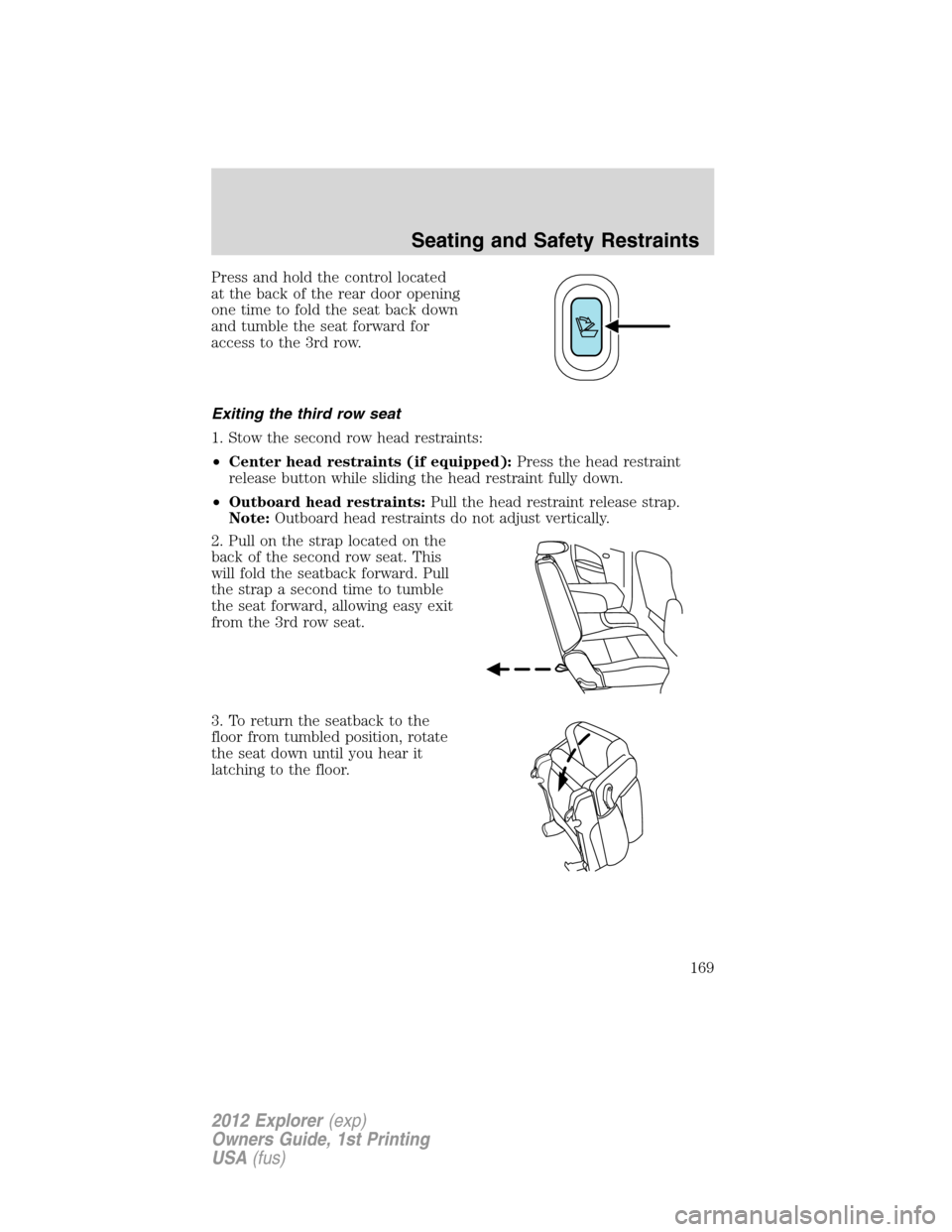
Press and hold the control located
at the back of the rear door opening
one time to fold the seat back down
and tumble the seat forward for
access to the 3rd row.
Exiting the third row seat
1. Stow the second row head restraints:
•Center head restraints (if equipped):Press the head restraint
release button while sliding the head restraint fully down.
•Outboard head restraints:Pull the head restraint release strap.
Note:Outboard head restraints do not adjust vertically.
2. Pull on the strap located on the
back of the second row seat. This
will fold the seatback forward. Pull
the strap a second time to tumble
the seat forward, allowing easy exit
from the 3rd row seat.
3. To return the seatback to the
floor from tumbled position, rotate
the seat down until you hear it
latching to the floor.
Seating and Safety Restraints
169
2012 Explorer(exp)
Owners Guide, 1st Printing
USA(fus)
Page 170 of 439
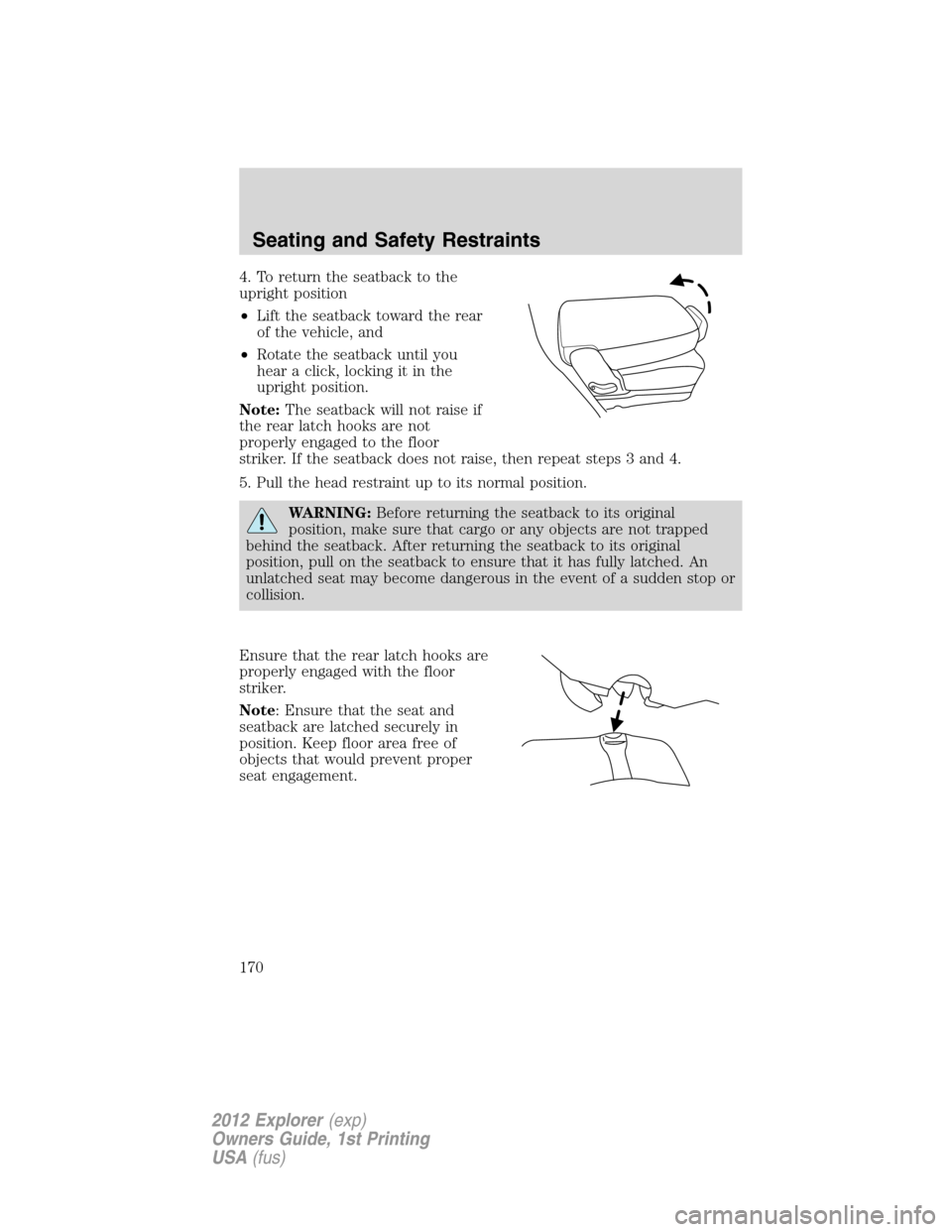
4. To return the seatback to the
upright position
•Lift the seatback toward the rear
of the vehicle, and
•Rotate the seatback until you
hear a click, locking it in the
upright position.
Note:The seatback will not raise if
the rear latch hooks are not
properly engaged to the floor
striker. If the seatback does not raise, then repeat steps 3 and 4.
5. Pull the head restraint up to its normal position.
WARNING:Before returning the seatback to its original
position, make sure that cargo or any objects are not trapped
behind the seatback. After returning the seatback to its original
position, pull on the seatback to ensure that it has fully latched. An
unlatched seat may become dangerous in the event of a sudden stop or
collision.
Ensure that the rear latch hooks are
properly engaged with the floor
striker.
Note: Ensure that the seat and
seatback are latched securely in
position. Keep floor area free of
objects that would prevent proper
seat engagement.
Seating and Safety Restraints
170
2012 Explorer(exp)
Owners Guide, 1st Printing
USA(fus)